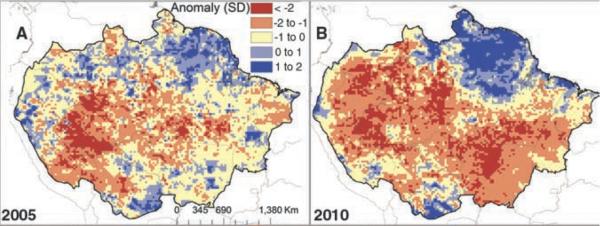
In Amazon, 2010 Drought Worse Than Rare 2005 Dry Spell

The Amazon rainforest suffered a drought last year even worse than what was billed as a "once-in-a-century" drought just five years before that, scientists now say.
Such a severe dry spell damages trees, meaning it could have unpleasant consequences when it comes to global warming, they added.
In 2005, the Amazon region was struck by a rare drought that killed trees within the rainforest. Instead of absorbing carbon dioxide from the atmosphere as plants normally do, the dead wood released the heat-trapping greenhouse gas as it rotted.
Now, scientists have discovered the Amazon suffered an even worse drought just five years later, causing the Rio Negro tributary of the Amazon River to fall to its lowest level on record.
Drought and tree death
Satellite observations of about 2 million square miles (5.3 million square kilometers) of Amazon rainforest showed there was a drop in rainfall over 1.1 million square miles (3 million sq. km) in 2010. In comparison, 2005 saw less rain over 733,000 square miles (1.9 million sq. km) of the region.
The causes of both these droughts may be high surface temperatures of the Atlantic Ocean.
Sign up for the Live Science daily newsletter now
Get the world’s most fascinating discoveries delivered straight to your inbox.
"High sea surface temperatures in the northern tropical Atlantic relative to those further south can mean that the band of rainfall where winds from the northern and southern hemispheres come together, known as the inter-tropical convergence zone, becomes displaced northward," researcher Simon Lewis, a forest ecologist at the University of Leeds in England, told OurAmazingPlanet. "This results in the displacement of rainfall to the north of the Amazon basin , leaving the southern portion with lower rainfall."
The scientists estimate there was a significant rise in dead trees spanning 1.2 million square miles (3.2 million sq. km) in the 2010 drought, compared with a similar rise across 965,000 square miles (2.5 million sq. km) in the 2005 dry spell. With more trees dying, the researchers conjecture that far more carbon was able to remain in the atmosphere last year as well.
"We will not know exactly how many trees were killed until we can complete forest measurements on the ground," said researcher Paulo Brando at Brazil's Amazon Environmental Research Institute. "It could be that many of the drought-susceptible trees were killed off in 2005, which would reduce the number killed last year. On the other hand, the first drought may have weakened a large number of trees, so increasing the number dying in the 2010 dry season."
Carbon and climate
In a normal year, the Amazon rainforest absorbs approximately 1.5 billion metric tons of carbon dioxide. (For comparison, the United States emitted 5.4 billion metric tons of carbon dioxide from fossil fuel use in 2009.) However, the researchers predict the Amazon forests will not absorb their usual amounts of the greenhouse gas in both 2010 and 2011, and instead will release a further 5 billion metric tons of carbon dioxide into the atmosphere over the coming years once the trees that are killed by the new drought rot.
Some global climate models suggest that Amazon droughts like these will become more frequent in the future as a result of greenhouse gas emissions further warming the planet and affecting climate patterns.
"Having two events of this magnitude in such close succession is extremely unusual, but is unfortunately consistent with those climate models that project a grim future for Amazonia," Lewis said. "If events like this happen more often, the Amazon rainforest would reach a point where it shifts from being a valuable carbon sink slowing climate change to a major source of greenhouse gasses that could speed it up."
"If greenhouse gas emissions contribute to Amazon droughts that in turn cause forests to release carbon, this feedback loop would be extremely concerning," Lewis added. "Put more starkly, current emissions pathways risk playing Russian roulette with the world's largest rainforest."
The most important next step is to make on-the-ground measurements of how many trees and of which species died during the 2010 drought, Lewis said. "Did the 2010 drought kill more or less trees for a given amount of water stress compared to 2005?"
The scientists will detail their findings in the Feb. 4 issue of the journal Science.










